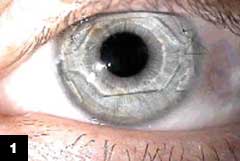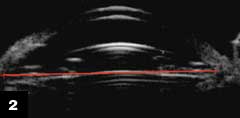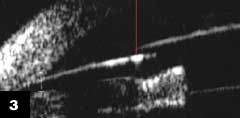Early results encouraging for Icare phakic IOL
The material and design of the lens provide gentle but stable angle fixation and minimize trauma.
|
|
The Icare phakic IOL by Cornéal seems to have found the ideal proportions, geometry, material and design for a natural, gentle but stable fitting in the eye, according to several surgeons.
“It’s not just another anterior chamber IOL, it’s a new anatomical and clinical reality,” said Philippe Sourdille, MD, at a meeting earlier this year.
Other surgeons at the same meeting sounded equally enthusiastic, and some said that this lens is the best they have used so far.
A total of 151 eyes have been implanted with the Icare in France, Italy, Poland and Spain. Maximum follow-up is only 10 months, but results so far are encouraging.
“We know for sure that the lens gives excellent optical stability, between + 0.5 D of attempted correction. Only in one case did we have a refractive surprise; we expected a –6 D and achieved a –1 D, probably due to misalignment during the echography measurements,” Dr. Sourdille said.
Minimizing trauma
|
|
The Icare is a one-piece foldable and injectable lens made of a soft hydrophilic acrylic. It has a 5.75-mm optic and an original footplate and haptic design.
“Every detail of this lens is conceived to minimize trauma. External traumatic impacts like patients rubbing their eyes or accidental blunt injuries are not aggravated by the presence of the implant, which is equally soft and elastic in the optic and haptics. The anterior surface of the lens is identical whatever the power used, and we have optimized the position of the haptics to avoid contact with the endothelium and the iris,” Dr. Sourdille said.
Also, the shape of the footplates, which have a large contact surface with the iridocorneal angle, helps absorb trauma with less chance of penetration into the trabecular tissue.
Preventing pupil ovalization
The new concept of the Icare is that it is placed into the anterior chamber, not pressed like other lenses with PMMA haptics, or attached like the Artisan, Dr. Sourdille said.
Transmission forces are symmetrically and equally distributed within the four footplates over a fairly large area, he said. This reduced tension of the lens prevents pupil ovalization, which is a typical problem of angle fixation. At the same time, this particular haptic design gives stability to the lens, preventing rotation and iris traction.
In the European series, there were only three cases of pupil ovalization between 0.5 and 1 mm, probably related to errors in the white-to-white measurement. However, the slight pupil ovalization did not progress, Dr. Sourdille noted.
Placed, not pressed in angle
|
|
The clinical follow-up of some of the patients was compared with high-frequency ultrasound images of the intraocular structures after IOL implantation using the Paradigm UBM and the Optikon 2000 Hi-scan equipment.
The images, produced and presented by Vittorio Picardo, MD, and Marina Modesti, MD, showed that the IOL was at an equal distance from the corneal epithelium and from the crystalline lens, in the perfect position for stability and safety. It was also clearly visible that the footplates were “placed, not pressed” in the angle, lying on the scleral spur, neither on the endothelium nor on the iris.
Gonioscopic images of the angle confirmed the positioning and adaptability of the haptics, slightly bending at the flexing junction without coming closer to the corneal endothelium and without exerting pressure on the uveal tissue.
Angle-to-angle distance was also visible on high-scan, confirming that the correct choice of IOL size had been made.
“As for any angle-supported lens, a precise preoperative measurement is crucial, and to date the ultrasonography is by far the best way to measure the angle-to-angle distance,” Dr. Sourdille said. “Thanks to these high-frequency scanning systems we can also image the anatomical relation of the lens with the ciliary sulcus and the reaction of the ciliary processes. It is not just a measuring system, it’s a physiological way to monitor the eye.”
A tissue-friendly implant
So far, fibrotic tissue reactions around the footplates have not been observed.
“It’s the biological compatibility of the hydrophilic material to prevent fibrosis, as well as other phenomena like synechiae and pupil dilation. The stable position of the lens, which cannot rotate, is another important factor,” Dr. Soudille said.
The “Bellucci’s sign,” as he named a gonioscopic maneuver suggested by Roberto Bellucci, MD, another surgeon who is currently implanting this lens, demonstrated that even after 6 months a gentle pressure exerted on the footplates will slightly move them, indicating the absence of tissue reaction in that area. Absence of tissue reaction also means reversibility of the procedure without any trauma to the internal structures of the eye, he said.
Another advantage of this lens is that it is almost invisible in the eye.
“Cosmetic appearance is not a negligible detail, because most of these patients are young and don’t want to have this foreign body showing through the eye, or a light reflex like that produced by PMMA and other hydrophobic materials,” Dr. Sourdille said.
Slight oversizing is better?
Dr. Bellucci and Simonetta Morselli, MD, who also presented their results, said they are extremely satisfied. They implanted the Icare in 10 patients and have a follow-up of 10 months.
“Implantation was easy, and the lens was correctly positioned under gonioscopic control,” Dr. Morselli said. “Mean refraction improved from preoperative –12.75 D to –1.37 D after implantation of the lens, with also a slight decrease of the astigmatism. Best corrected visual acuity increased about one line.”
No sign of postoperative inflammation was reported. In one case, incorrect sizing caused a slight decentration of the lens, leading to some glare effects at night.
“As with all phakic IOLs, sizing is crucial,” Dr. Morselli said. “We found that slight oversizing might be better than undersizing, because these lenses are very soft and tend to rotate if they are too small. On the other hand, slight oversizing creates no problem, because the footplates have a soft and firm contact with the ocular tissue, and don’t cause angle erosion.”
Having tried all types of phakic IOLs, the two surgeons said that Icare is the lens with better results and fewer postop complications. This is due to the unique material and design, with a large optic and soft, well-balanced haptics, providing a gentle but stable fixation. Further advantages of the lens, they added, are that it is easy to implant, injectable and available in a wide range of dioptric powers.
For Your Information:
- Philippe Sourdille, MD, can be reached at PhS, Le Chaigne, 16120 Touzac, France; +(33) 545-21-25-51; e-mail: philippe.sourdille@wandoo.fr. Dr. Sourdille is a paid consultant for Cornéal.
- Vittorio Picardo, MD, and Marina Modesti, MD, can be reached at Studio Oculistico, Via Nomentana 311, 00162 Roma, Italy; +(39) 068-54-7845; fax: +(39) 068-535-5461; e-mail: eyeboss@vpicardo.it. Drs. Picardo and Modesti have no direct financial interest in the products mentioned in this article, nor are they paid consultants for any companies mentioned.
- Roberto Bellucci, MD, and Simonetta Morselli, MD, can be reached at Ospedale di Verona, Unità Operativa di Oculistica, Piazzale Stefani 1, 37126 Verona, Italy; +(39) 045-807-3035; fax: +(39) 045-807-2289; e-mail Dr. Bellucci: roberto.bellucci@mail.azosp.vr.it; e-mail Dr. Morselli: morsell@tiscali.it. Drs. Bellucci and Morselli have no direct financial interest in the products mentioned in this article, nor are they paid consultants for any companies mentioned.
- Cornéal, manufacturers of the Icare IOL, can be reached at 31 Rue des Colonnes, 75012 Paris, France; +(33) 1-43-42-9393; fax: +(33) 1-43-07-0190; e-mail: export@corneal.com.



